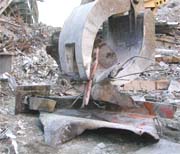|
Found Art
Parts of Calder Sculpture Retrieved from Trade Center
 Listen to Noah Adams' interview with Alexander S. C. Rower. Listen to Noah Adams' interview with Alexander S. C. Rower.
Oct. 22, 2001 -- Millions of dollars worth of art was lost in the World Trade Center attacks. But many parts of one of the more famous works -- Alexander Calder's "Bent Propeller" -- have been found, thanks to an all-out effort by the famous sculptor's heirs.

|
|
Calder's "Bent Propeller" as it looked standing in the plaza at 7 World Trade Center.
Photo: Art Resource
|
"Very close to 50 percent" of the sculpture has been found, said Alexander S.C. Rower, Calder's grandson and director of the Calder Foundation.
The found pieces are just barely identifiable as belonging to the red, 25-foot-tall sculpture that stood in the plaza in front of 7 World Trade Center. The parts are twisted and torn, covered in dirt, and bearing scorch marks. Before the attack, the piece -- painted in the artist's signature "bright Calder red" -- resembled "three boomerangs curved through their middles," Rower tells Noah Adams on All Things Considered. The sculpture, commissioned for the Trade Center, was created in 1970.
"I was in a state of shock for about a week" after the Sept. 11 attacks, Rower says. The Calder Foundation created a color flyer and circulated it among people working at the cleanup site, and foundation official Victoria Leacock has been on the scene every night passing out more flyers and looking for pieces.

|
|
Part of the sculpture is recovered at the cleanup site.
Photo: Courtesy the Calder Foundation
|
Finding the sculpture amid all that wreckage may seem like an impossible task, but Rower says it's easier than it sounds. The metal is about a half-inch thick, and no other major structural element of the World Trade Center has the same dimensions, he says. Also, the bolt-holes that run in a zigzag pattern along the edges of the sculpture make the pieces relatively easy to pick out.
Still, even on Sept. 11, Rower knew the damage would be extensive. "You can assume that it kind of blew apart as No. 7 fell on it," he says, noting the building was 47 stories tall.
Although half the sculpture has been recovered, Rower is uncertain about its future. "Our goal is to of course restore the work if possible," he says. "It could be a Phoenix rising from the ashes."
Other Resources
An NPR report on the art lost at the World Trade Center
The Calder Foundation
|